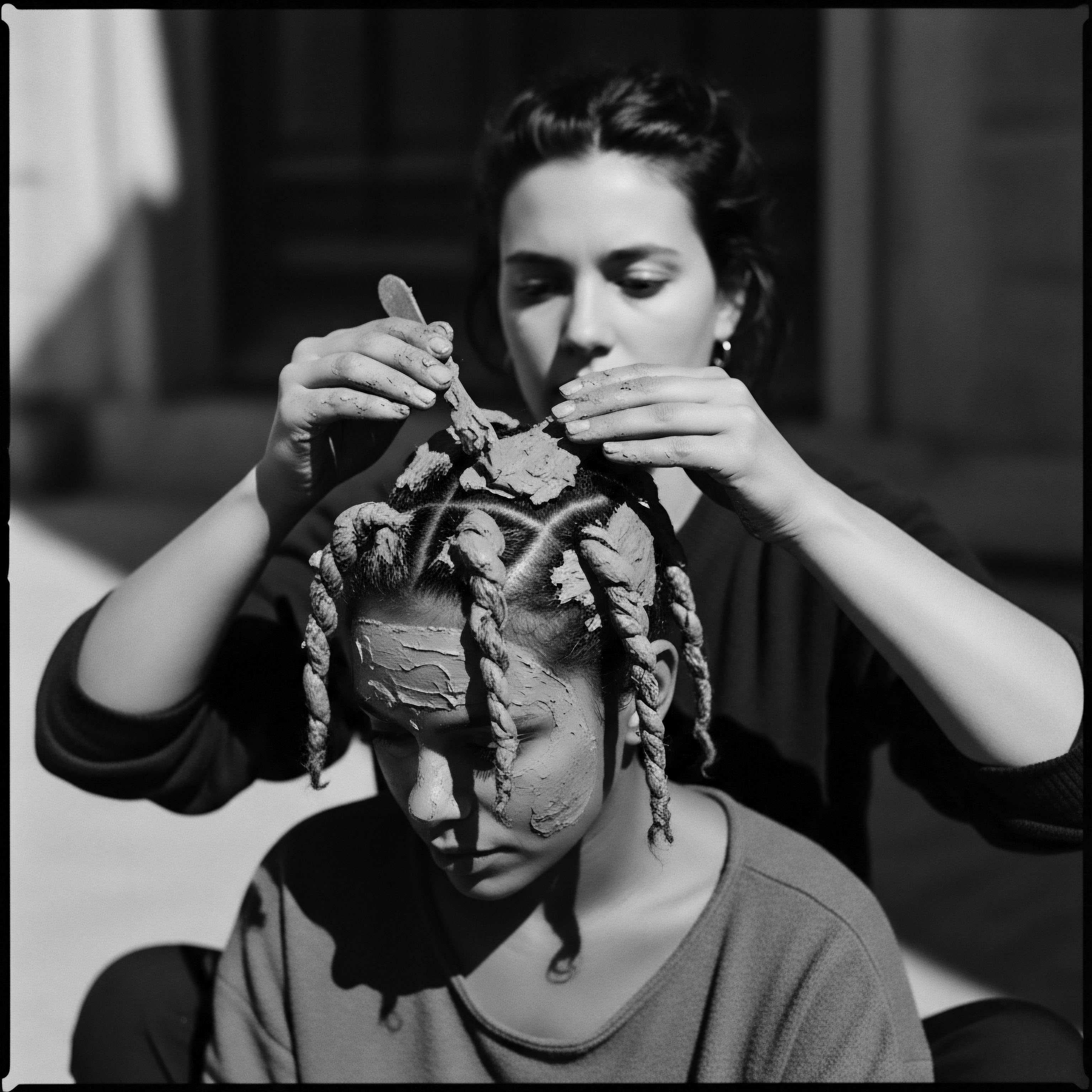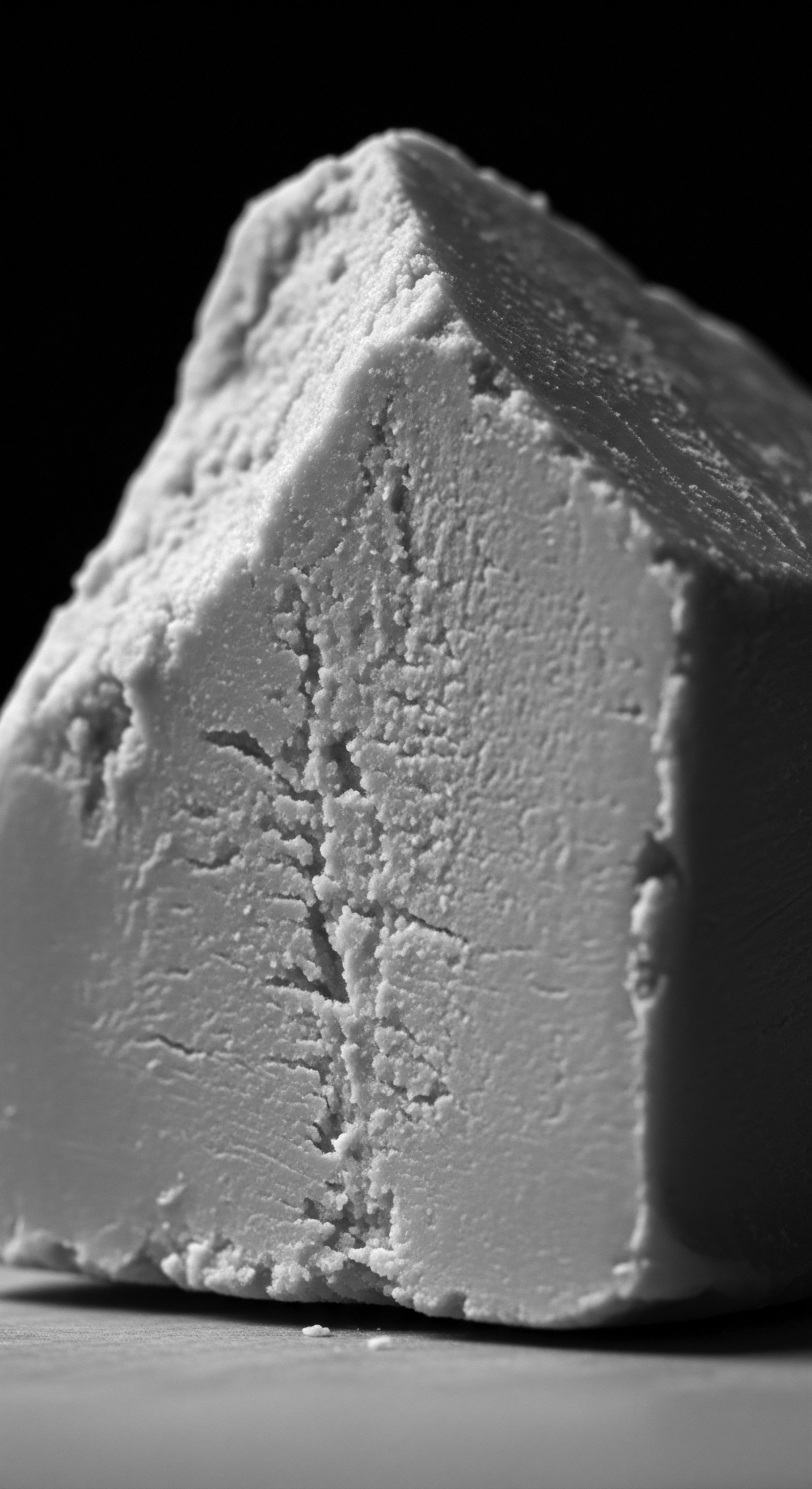
Fundamentals
Within the vast, interconnected tapestry of human existence, where the rhythms of our bodies echo the grand designs of nature, certain elemental forces quietly shape our well-being. The term Endocrine Disruptors, or EDs, points to a class of external agents, often unseen in our daily lives, that possess the capacity to influence the intricate symphony of our internal communication systems. These systems, governed by hormones, act as messengers, directing everything from growth and mood to the very cycles of life. A fundamental understanding of EDs begins with recognizing their potential to subtly alter these vital hormonal signals, shifting the delicate balance that governs our health and the vibrancy of our hair.
Imagine the body as a sacred garden, where each plant thrives under specific conditions, guided by the sun, water, and soil. Hormones are akin to the unseen forces that tell a seed when to sprout, a leaf when to unfurl, or a bloom when to open. Endocrine Disruptors, in this analogy, represent subtle environmental shifts or introduced elements that might subtly alter these instructions, causing a plant to grow in an unexpected way, or perhaps to wither before its time. Their influence, while not always immediately apparent, can reverberate through generations, impacting the very lineage of our physical expressions, including the resilience and texture of our hair.
The basic meaning of Endocrine Disruptors stems from their ability to mimic, block, or otherwise interfere with the body’s natural hormones. These chemical interlopers can originate from a surprising array of sources, from the materials used in our everyday containers to certain components found in personal care items. Their presence introduces a dissonance into the body’s finely tuned hormonal orchestra, leading to responses that may not align with optimal health.
Endocrine Disruptors are external agents capable of subtly altering the body’s natural hormonal communications, influencing a spectrum of physiological processes.

Tracing Early Understandings
Even in ancient traditions, a deep intuitive wisdom guided communities towards a profound connection between external substances and internal harmony. While the scientific language of “endocrine disruptors” was yet to be articulated, ancestral practices often emphasized the use of natural, earth-derived ingredients for hair and body care, intuitively avoiding elements perceived as harsh or unnatural. This inherent understanding of the body’s delicate equilibrium, passed down through oral traditions and communal rituals, served as an early form of protective knowledge.
Consider the reverence for plants like Chebe in Chad or Henna in North Africa and the Middle East. These were not merely cosmetic aids; they were seen as extensions of the earth’s healing power, chosen for their perceived ability to strengthen, nourish, and protect hair without introducing disharmony. The meaning of ‘care’ in these contexts was holistic, extending beyond superficial appearance to encompass a deeper sense of well-being, acknowledging the interconnectedness of body, spirit, and environment.
This ancestral discernment, rooted in centuries of observation and communal experience, laid the groundwork for a more sophisticated understanding of how external agents can impact internal systems. The focus was on fostering a harmonious relationship with the natural world, recognizing that what we apply to our bodies, especially our hair, can indeed become a part of us, influencing our internal landscape in ways both seen and unseen.

Intermediate
Stepping beyond the fundamental comprehension, the intermediate interpretation of Endocrine Disruptors delves into their mechanisms of action and the broader implications for textured hair heritage. These agents do not operate through brute force; instead, they operate with a deceptive subtlety, often mimicking the molecular structure of our own hormones. This mimicry allows them to bind to hormone receptors, sending false signals, or conversely, to block natural hormones from binding, effectively silencing essential communications. The significance of this interference extends to developmental stages, reproductive health, and metabolic regulation, all of which indirectly influence hair growth cycles and scalp vitality.
For communities with textured hair, the historical journey has often involved navigating complex societal pressures that have, at times, encouraged the adoption of hair care practices and products far removed from ancestral wisdom. This historical context provides a critical lens through which to consider the pervasive presence of Endocrine Disruptors. The very meaning of beauty and acceptance, shaped by external standards, led many to utilize chemical formulations designed to alter the natural curl pattern, inadvertently introducing novel chemical exposures into daily routines.

The Chemical Crossroads of Hair Care
The mid-20th century marked a profound shift in hair care, particularly for Black women. The desire for straightened hair, often linked to perceived professionalism and social mobility, led to the widespread adoption of chemical relaxers. These formulations, while offering a dramatic alteration of hair texture, often contained potent chemicals. The understanding of Endocrine Disruptors deepens when we consider that some of these compounds, or their breakdown products, may interact with the body’s hormonal systems.
The transition from traditional practices, relying on plant-based oils, butters, and cleansing agents, to chemically intensive regimens, represents a significant crossroads. The traditional knowledge of hair care, often passed down through generations, centered on nourishment, protection, and respectful maintenance of the hair’s natural state. The advent of modern chemistry, while promising convenience and conformity, also introduced a new set of considerations regarding long-term bodily impacts.
The historical adoption of chemical hair treatments within textured hair communities introduced new chemical exposures, some potentially acting as Endocrine Disruptors.

Identifying Common Disruptors in Hair Care
While not all chemicals in hair products are Endocrine Disruptors, certain classes have raised concerns due to their known or suspected hormonal activity. Understanding these categories is crucial for those seeking to honor their hair’s heritage through informed choices.
- Phthalates ❉ These compounds are often used to make plastics more flexible and can also be found in fragrances within hair products. Their presence has been linked to reproductive and developmental issues.
- Parabens ❉ Commonly used as preservatives in cosmetics and hair care items, parabens have been shown to mimic estrogen in laboratory studies, raising questions about their long-term impact on hormonal balance.
- Formaldehyde-Releasing Agents ❉ Found in some hair straightening treatments, these chemicals can release formaldehyde, a known carcinogen, which also has potential endocrine-disrupting properties.
- Certain Heavy Metals ❉ Historically, some hair dyes and treatments contained heavy metals, which can accumulate in the body and interfere with various enzymatic and hormonal processes.
The meaning of “care” for textured hair, when viewed through this intermediate lens, expands to encompass a conscious awareness of ingredients. It involves a discerning eye, a willingness to question, and a commitment to seeking formulations that align with ancestral wisdom of purity and harmony. The journey back to honoring the hair’s natural state is not merely aesthetic; it is a profound reclamation of autonomy over one’s body and heritage.
This intermediate exploration acknowledges that the historical narrative of textured hair care is complex, intertwined with societal pressures, economic realities, and evolving scientific understanding. It calls for a deeper look into the ingredients that have touched our strands for generations, inviting a more intentional approach to hair wellness that respects both tradition and contemporary knowledge.

Academic
The academic elucidation of Endocrine Disruptors (EDs) delineates them as exogenous substances or mixtures that alter function(s) of the endocrine system and consequently cause adverse health effects in an intact organism, or its progeny, or (sub)populations. This precise designation, adopted by the World Health Organization and other leading scientific bodies, underscores the systemic and often subtle yet pervasive impact of these agents on biological integrity. Their modus operandi extends beyond simple agonism or antagonism at receptor sites; EDs can also interfere with hormone synthesis, transport, metabolism, and elimination, or modify receptor expression and signal transduction pathways. The complexity of their interaction with the neuroendocrine, reproductive, metabolic, and immune systems necessitates a rigorous, multi-disciplinary investigative approach.
The significance of EDs within the academic discourse on human health, particularly for marginalized communities, cannot be overstated. For individuals with textured hair, especially those of Black and mixed-race descent, the historical and ongoing exposure to certain chemicals in personal care products presents a compelling case study for environmental justice and health disparities. The persistent societal valorization of straightened hair, often enforced through discriminatory practices, led to a disproportionate reliance on chemical hair relaxers and other altering treatments within these communities. This reliance, spanning decades, has created a unique exposure pathway for compounds now recognized as potential EDs.

The Chemical Nexus ❉ Hair Relaxers and Endocrine Disruption
The academic lens reveals a disconcerting intersection between cultural practices, commercial pressures, and environmental health. Chemical hair relaxers, designed to permanently alter the disulfide bonds within the hair shaft, have historically contained a cocktail of chemicals. While formulations have evolved, concerns persist regarding the presence of phthalates, parabens, alkylphenols, and other substances that exhibit endocrine-disrupting activity. These chemicals are not merely inert ingredients; they possess the capacity to be absorbed through the scalp, particularly when the skin barrier is compromised by chemical burns, abrasions, or heat from styling tools, entering systemic circulation.
A substantial body of research has begun to illuminate the long-term health consequences associated with chronic exposure to these products. One particularly salient area of investigation concerns the heightened incidence of certain gynecological conditions among Black women. For instance, a prospective cohort study, the Black Women’s Health Study, initiated in 1995, has provided compelling evidence linking hair relaxer use to an elevated risk of uterine leiomyomata, commonly known as uterine fibroids. Researchers observed a dose-response relationship, where frequent and long-term use of relaxers correlated with a greater likelihood of developing fibroids (Coogan et al.
2012). This particular finding holds profound meaning for Black women, who experience uterine fibroids at significantly higher rates, with earlier onset and greater severity, compared to women of other racial backgrounds (Baird et al. 2003). The connection suggests a potential environmental contributor to a condition that imposes substantial health burdens, including pain, heavy bleeding, and a leading cause of hysterectomies.
Long-term use of chemical hair relaxers, historically prevalent in Black communities, is linked to increased risk of uterine fibroids, highlighting a critical intersection of cultural practice and endocrine disruption.
The implications of such findings extend beyond individual health outcomes. They underscore the systemic nature of environmental health disparities, where cultural norms and economic factors intersect to create disproportionate exposures. The persistent marketing of chemical straighteners, often without adequate disclosure of potential health risks, raises ethical questions about corporate responsibility and public health advocacy within a historical context of racial inequality.

Beyond the Hair Shaft ❉ Systemic Repercussions
The academic exploration of EDs in hair care extends to other health endpoints, including breast cancer risk and pubertal development. Studies have identified phthalates and parabens, frequently found in hair products, as compounds with estrogenic activity. Chronic exposure to these xenoestrogens, particularly during critical windows of development, could potentially influence cellular proliferation and differentiation, contributing to increased disease susceptibility.
The meaning of ancestral hair practices, once viewed through a purely cultural or aesthetic lens, gains a renewed scientific validation in this context. Traditional methods of hair care, often utilizing ingredients such as Shea Butter, Coconut Oil, Aloe Vera, and various herbal infusions, inherently minimized exposure to synthetic chemicals. These practices, born from generations of observation and adaptation to local flora, provided nourishment and protection without introducing agents that could interfere with the body’s internal chemistry. The shift away from these methods represents a departure from an inherently protective, ancestral wisdom.

A Comparative View of Hair Care Philosophies
To further illustrate the divergence, consider a comparative examination of traditional and contemporary hair care approaches, specifically regarding ingredient philosophy and potential endocrine impact.
| Aspect Ingredient Sourcing |
| Ancestral/Traditional Practices Locally harvested plants, oils, and minerals (e.g. kola nuts for cleansing, palm oil for conditioning). Emphasis on natural, often edible, components. |
| Modern/Conventional Practices (Historical Context) Synthetically derived chemicals, petroleum-based ingredients, artificial fragrances. Global supply chains with complex chemical compositions. |
| Aspect Primary Goal |
| Ancestral/Traditional Practices Nourishment, protection, spiritual significance, celebration of natural texture. Hair as a conduit for ancestral connection. |
| Modern/Conventional Practices (Historical Context) Alteration of texture (straightening), extreme styling, quick fixes, often driven by Eurocentric beauty standards. |
| Aspect Potential ED Exposure |
| Ancestral/Traditional Practices Minimal to none. Ingredients generally biodegradable and non-systemically active in a disruptive manner. |
| Modern/Conventional Practices (Historical Context) High potential. Presence of phthalates, parabens, formaldehyde-releasers, and other synthetic compounds linked to hormonal interference. |
| Aspect Application Method |
| Ancestral/Traditional Practices Gentle handling, finger-combing, protective styles, co-washing with natural clays or herbs. Scalp massage with natural oils. |
| Modern/Conventional Practices (Historical Context) Chemical processing requiring direct scalp contact, heat styling, tension from tight styles. Potential for scalp irritation and enhanced absorption. |
| Aspect This comparison underscores a fundamental divergence in philosophy, from holistic well-being to aesthetic conformity, with profound implications for internal physiological balance. |
The academic investigation of Endocrine Disruptors thus provides a scientific framework for understanding the wisdom embedded in ancestral hair care. It offers a powerful rationale for the contemporary natural hair movement, framing it not merely as a stylistic choice but as a crucial public health initiative, a reclamation of bodily autonomy, and a profound act of honoring one’s heritage. The challenge for future inquiry involves further refining exposure assessments, identifying specific vulnerable populations, and advocating for policy changes that prioritize health equity and environmental safety within the beauty industry.

Reflection on the Heritage of Endocrine Disruptors
The journey through the intricate landscape of Endocrine Disruptors, viewed through the profound lens of textured hair heritage, reveals more than just scientific definitions; it unearths a deeper narrative of resilience, adaptation, and the enduring wisdom of our ancestors. The Soul of a Strand ethos, a guiding light in this exploration, reminds us that hair is not merely a biological appendage but a living archive, a testament to journeys undertaken, traditions preserved, and identities expressed. The very concept of Endocrine Disruptors, while modern in its scientific articulation, echoes ancient understandings of balance and disharmony, reminding us that what we apply to our crown truly touches the core of our being.
For generations, the care of textured hair was an intimate ritual, a transfer of knowledge from elder to youth, rooted in the earth’s bounty. The plants, oils, and clays used were understood not just for their immediate effects but for their inherent connection to well-being. This ancestral perspective, a quiet rebellion against manufactured norms, instinctively sidestepped the very elements we now identify as potential endocrine disruptors.
The current re-emergence of natural hair practices, therefore, is far more than a trend; it is a resonant homecoming, a conscious decision to align with the protective wisdom passed down through bloodlines. It is a reclaiming of autonomy over our bodies and a profound act of self-love, honoring the innate beauty and strength of our hair in its unadulterated state.
The path ahead involves a continuous dialogue between ancestral reverence and scientific discovery. As we continue to uncover the subtle influences of Endocrine Disruptors, our understanding of their meaning within the context of hair care will only deepen. This ongoing exploration serves as a powerful call to action, urging us to question, to seek transparency, and to champion practices that safeguard our health and the health of future generations.
Our hair, in its magnificent diversity, stands as a vibrant symbol of this heritage, a testament to a legacy of care that transcends time, forever connected to the very essence of who we are and where we come from. The unbound helix, our textured strands, continues its journey, whispering stories of the past while shaping a future of conscious, heritage-informed well-being.

References
- Baird, D. D. Dunson, D. B. Hill, M. C. Cousins, D. & Schectman, J. M. (2003). High cumulative incidence of uterine leiomyomata in black and white women ❉ ultrasound evidence. American Journal of Obstetrics and Gynecology, 188(1), 100-107.
- Coogan, P. F. Rosenberg, L. Bethea, T. N. & Adams-Campbell, L. L. (2012). Hair product use and fibroids in the Black Women’s Health Study. Environmental Health Perspectives, 120(11), 1600-1606.
- Quindlen, M. E. Adkins, A. D. & Zota, A. R. (2020). Chemical Exposures and Health Outcomes in Black Women ❉ A Review of the Literature. Current Environmental Health Reports, 7(3), 295-306.
- White, A. J. VoPham, T. Bethea, T. N. Coogan, P. F. Rosenberg, L. & Palmer, J. R. (2019). Hair product use and breast cancer risk in a racially diverse cohort of women. International Journal of Cancer, 145(7), 1735-1742.
- World Health Organization/United Nations Environment Programme. (2012). State of the Science of Endocrine Disrupting Chemicals – 2012. WHO Press.
